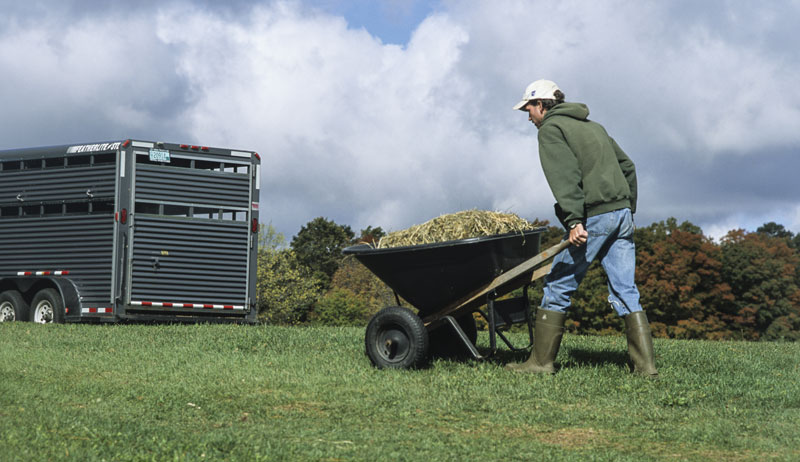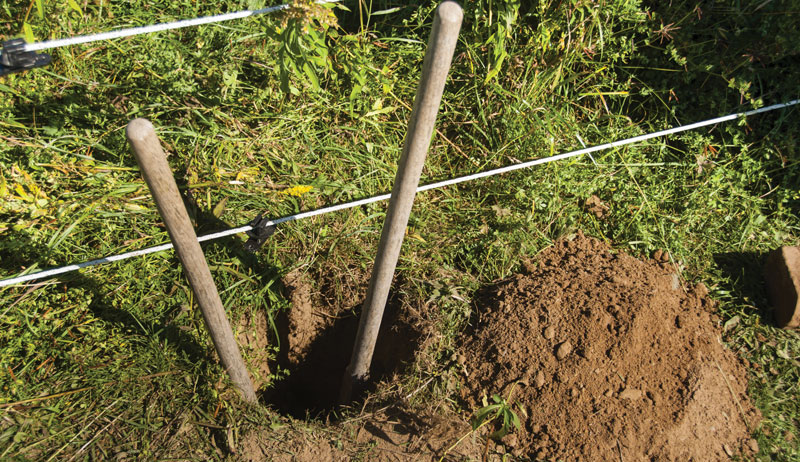
Have you ever noticed that old tools don’t really become obsolete? Sure, there may be a newer or faster type of power tool or machine to be had for a particular job. But this doesn’t mean that the original, older solution is any less effective than it was back in the day.
A tool doesn’t stop doing its job just because there is an alternative solution. Years ago, farmers didn’t necessarily have electricity and gasoline at their disposal. And yet, the work still got done. So here is an overview of 13 great hand- and human-powered tools that have stood the test of time. Any of them would find use on any modern homestead.
Now we aren’t suggesting you abandoned modern machines and tools. On the contrary, these modern marvels have their place and make it possible for one or two people to do work that might have taken a crew (or large family!) in the distant past. But farm hand tools are effective, efficient and generally easy to use.
In many cases, especially for small jobs, you can get farm jobs done faster by grabbing a simple hand tool than by taking the time to prepare a machine. Plus, there’s something to be said for the satisfaction and exercise of manual work.
Pitchfork
I’ll go out on a limb and say that you probably don’t put up loose hay like they did in the old days. That’s no matter. You still need a pitchfork or two around your place.
Regardless of what type of hay bales you do use—small squares, large squares, round bales—there is always chaff and remnants left behind. Sometimes it’s out in the pasture where the cows have trampled hay into the ground. Sometimes it’s at the bottom of the stack inside the barn.
Either way, a good pitchfork can help you make short work of the cleanup. Likewise, they’ll work equally well on similar materials such as straw or grass clippings. One will also turn the compost pile.
In a pinch, a pitchfork can also double as a garden fork.
Wheelbarrow
Small carts pulled by UTVs or small tractors have their uses. So do tractor front-end loaders. But it’s hard to beat the simplicity and portability of a basic wheelbarrow. It’s small and maneuverable.
You can squeeze into a tight spot in the garden or down the barn aisle with ease.

Rocks, sand, bedding, old hay, compost, mulch—wheelbarrows can handle it all and more. Again, it’s a matter of convenience. For many jobs, a wheelbarrow will work just fine.
For serious farming tasks, contractor-grade two-wheeled wheelbarrows are an excellent option. They’re sturdier and less prone to tipping under heavy loads. Plus, you can maneuver them one-handed—a surprisingly useful time-saving function.
On the other hand, single-wheeled wheelbarrows might be more popular for people looking for something lighter and smaller.
Locking Pliers
Every farm needs several pairs of these indispensable hand tools. The name “locking pliers” is the generic name. The more familiar term in the U.S. is the brand name “Vise-Grip.”
Regardless of the name, there are a few reasons why these tools are handy on the farm. They grip objects just like a regular pair of pliers. But they feature an extra-tension system that forces additional pressure onto the handles. It holds them without any other assistance.
This is incredibly useful for worn, rusty or otherwise stuck nuts—a scenario that is bound to occur on most farms.
While not a replacement for your regular wrenches and pliers, locking pliers are handy for gripping, bending, twisting, removing and otherwise manipulating stuck nails, screws, metal and other materials. Use with care though. It’s actually possible to accidentally damage the item you’re trying to grip.
Read more: Take care of your garden tools and they’ll take care of you.
Stirrup Hoe
Weeds beware! Unlike a traditional hoe—which you also probably need—a stirrup hoe features a sharp horizontal blade for slicing off weeds very close to the surface.
This is handy because it allows you to do some fast weeding of a large area in a short amount of time. Also, it doesn’t disturb the soil or crops very much.
Ax
A basic ax—and the skills to use it safely and effectively—is another example of a situation where you can save time on small jobs.
You’re probably not going to split an entire winter’s worth of wood with an ax if you have a pneumatic splitter (though you could). But let’s say a single small tree or possibly a large branch falls in the pasture, on a fence or near the barn.
An ax might be just the tool to quickly trim branches, buck the log into a few manageable pieces and even split those logs into firewood, if needed.
Handsaw
“Hand” in hand with the ax should be a simple handsaw—something short, around 15 inches.
Provided it’s sharp (admittedly, they don’t last forever), this is a tool that is so simple, so lightweight and so efficient that you’ll find yourself saving time over and over if you keep one on hand.
For small jobs and quick repairs, a good handsaw will cut through a 2-by-4, zip through fallen branches and even shorten a fence post quicker than you can say, “Put some gas in the chainsaw.”
Post Driver
No matter what kind of farming, gardening or homesteading you might do, odds are that sooner or later you’ll find a need for some T-posts. These incredibly handy steel fence posts are lightweight and come in various lengths from about 5 to 8 feet. They’re useful for constructing all sorts of temporary and permanent fencing.
Post drivers can be used to build garden fencing, snow fencing to prevent unwanted winter drifts and certain types of animal fencing.
While gas-powered options for driving the posts into the ground exist, a hand-powered T-post driver is fairly easy to use as long as the soil isn’t super compacted. They are durable tools without any moving parts that should last many years.
Read more: Keep things secure with these farm fencing fundamentals.
Posthole Diggers
Manual, arm-powered posthole diggers are very useful farm hand tools. While you could put up an entire fence this way, powering through each hole by hand in a self-sufficient way, most folks turn to a 3-point tractor attachment or other machine for this job.

But for doing just a handful of posts, you almost can’t beat a hand digger.
Perhaps you have a couple posts that need replacing, or you have some kind of utilitarian or decorative project that only requires a handful of holes. Or maybe you have limited space around your project and need a fence hole in a tight spot that is impossible to reach with a tractor.
Handheld posthole diggers are lightweight, simple and easy to use. One will get the job done very quickly. Sure, digging holes this way can be a real workout, but it’s still valuable if you don’t have dozens or hundreds of holes to dig.
Digging Bar
Make no mistake about this one. Whether you’re a fan of hand tools or typically opt for the machines, you need a digging bar around the farm. These are typically fairly heavy steel bars about 6 feet long, with a narrow blade (kind of like a large flat screwdriver) on one end and a tamping head on the other.
Digging bars are easy to use and perfect for prying large rocks out of the garden or posthole that you’re digging, or tamping down the soil after replacing a fence post. You’ll find them useful during the winter for breaking up ice blocks or densely packed snow.

If your property has a history and was once an old-time homestead, you might even find a few hand-forged digging bars around the place. They’re useful and historic. Just be sure to wear goggles when using one.
Scoop Shovel
Looking a little like something off of an 1880s steam locomotive, scoop shovels are useful for much more than shoveling coal. Besides keeping one of these farm hand tools handy in the cattle or dairy barn for manure cleanup and bedding removal, you’ll likely want to keep another (read: clean!) scoop shovel around for various other tasks.
Available in aluminum or durable plastic, scoop shovels are ideal for shoveling grain and moving around loose sand or similar materials. Besides that, scoop shovels make dandy snow shovels. They’re especially good at moving those thick, heavy, wet snows at the end of winter.
A scoop shovel can take big bites of snow, and then slide the load along the ground to a different spot, saving your back some effort. They’re useful for shoveling roofs, too!
Read more: A good shovel is key to good growing. Here are some tips for picking the right tool.
Garden Fork
And speaking of garden forks: When it’s time to get the garden ready in the spring and turn over the soil, you might initially think to choose a rototiller, maybe a stand-alone gas-powered model or a 3-point attachment for a small tractor. But don’t overlook the possibility of utilizing a garden fork instead and trying a no-till technique.
There are plenty of potential advantages to a no-till garden. But you’ll still need to work the upper soil a bit to prepare it for planting. This is where your garden fork comes into play.
Additionally, garden forks are generally useful to have around the garden, ready to pick up piles of weeds or scoop up old plant material (such as all those spent tomato vines!) in the fall.
Cargo Sled
If your climate receives any amount of serious snow in the winter, invest in a cargo sled. Also called utility sleds, these robust, durable tools are perfect for moving bulky and heavy loads around the farm. On those deep cold winter days, after the trails and driveways around your barnyard have been freshly plowed, a cargo sled will easily haul loose materials such as straw and sand as well as things such as feed bags, small hay bales, bedding and more.
And after you catch up on the farm chores and are ready for some fun, cargo sleds are popular for carrying gear out onto the lake while ice fishing.
You can pull cargo sleds with ATVs/UTVs and snowmobiles of course. But they’re pretty useful when pulled by hand, too. Just like a wheelbarrow, a cargo sled is maneuverable when used by hand and can fit into some tight locations.
Are you ready to get to work? You’ll be amazed at how much you can accomplish with these inexpensive farm hand tools.
This article originally appeared in the May/June 2021 issue of Hobby Farms magazine.




